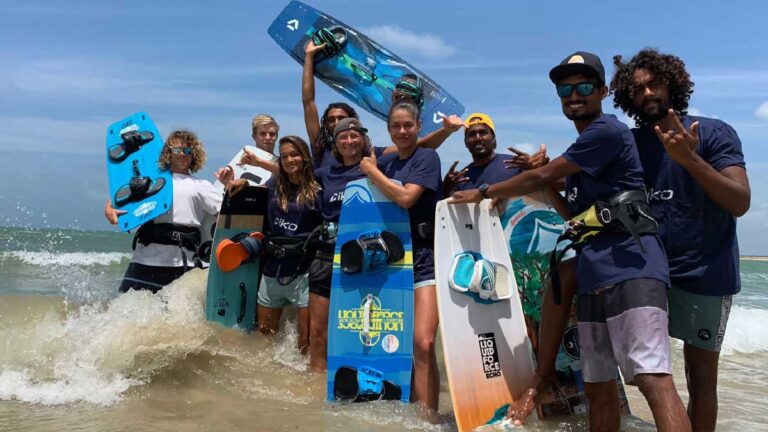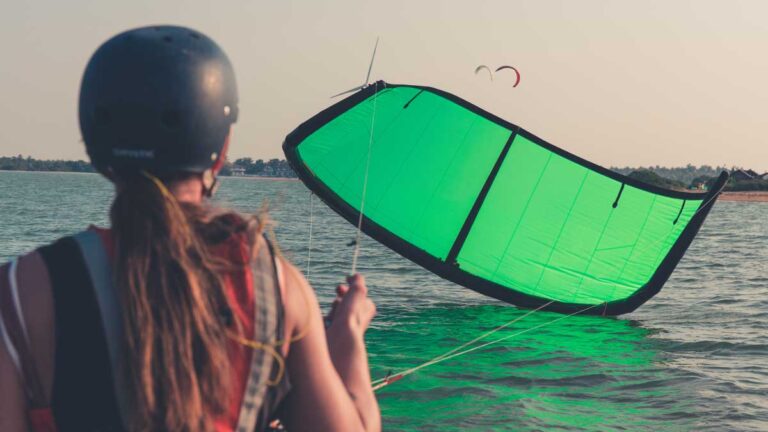Path to progress kitesurfing
Once the IKO level 3 course is completed, kite surfers can follow the below road map to become a proficient rider.
- Ride both sides: After the level 3 IKO course, riders will get good at going on short rides on both sides. From here on one must try and get comfortable riding downwind and upwind. During this level, riders focus on kite placements and board placements. Some of the things to watch out are body positionings, toe and heel placements, and leaning back into the harness.
- Upwind Riding: Once the rider feels comfortable with the water start and ride for short distances on both sides, he/she can focus on getting proficient at riding upwind. This is an important step in the journey of a kite surfer. Once you master upwind riding, kite surfers can independently go out riding. During this stage, riders must focus on edging the board towards the upwind direction and work on, the board stance. It’s important to keep your shoulders and hips open.
- Sliding Transition: The sliding transition is the easiest way to change your direction of riding. Starting with your kite high, carve upwind steering your kite to 12 o’clock. Once it reaches the zenith, your body weight should be evenly distributed to both feet. As you steer your kite in the new direction add some power and extend your leg shifting your weight to the new back leg. Timing is the key to success so make sure the up movement is slow and smooth and as you transfer weight to your new direction make sure the kite has similar power as a water start. Key elements to remember are to carve upwind, slowly steer the kite to 12, evenly distribute weight on both legs and dive the kite to the other side.
- Toe Side Transition: Toe side transition is where the board passes through a 180-degree turn and you can choose to change your stance. For this, steer your kite up and as the kite starts to turn and the line tension increases start to carve your board downwind by shifting your body weight over to the toes of your back feet, keep on carving the board through the whole turn to maintain speed and keep the tension in the kite. Finally slide or pop to the board side.
- Ride Toe side: Going along the heel side edge is the standard way of riding, the opposite of this is called toe side edge. This is the foundation of many moves in kitesurfing. To switch from heel side to toe side, you can either slide the board or pop. To slide from heel side to toe side fly your kite either to 11 or 1’o clock. Place your hand close to the center of the bar and find a central and well-balanced body position, transfer your body weight, and initiate a tight curvy turn into the wind. Release the heel side edge, rotate your hips, and as the board comes around shift your weight to the toes of your new back foot.
- Board Pops: The pop is an essential exercise and is the base of nearly every move in kiteboarding. Mastered correctly it is the key to unlocking many moves down the road. Find a balanced body position and ride along the kite stable at a 45-degree angle, put your hands close to the center of the bar. To perform the pop, fly the kite a little bit higher and carve the board hard against the wind driving force down through the heel side edge, keep the bar in its initial position as you want to pop without the kite pulling you out of the water, now pop the board out of the water by stepping down on your back foot and pulling up your front foot. At this moment the board should go in a vertical position, so the tail is the last to leave the water.
- Jump: A jump is your ticket to fly and the foundation of many freestyle tricks. Start with lots of speed, edge your board hard upwind while simultaneously steering up the kite to 12’o clock to get extra height and more time in the air. Before landing direct your kite down. To get the perfect timing have the bar depowered while edging your board upwind. As the kite hits 12’o clock pop the board upwind and pull in the bar for extra height, keeping your knees in and body tensed. Once you reach the apex of your jump start looking for a smooth landing and direct the kite down releasing the tension in the bar when you are halfway down.
- Jump Transition: A jump transition is a cool and convenient way to change your riding direction. The kite steering is similar to a normal transition just a little faster and more aggressive. Ride along with more speed than in a normal transition, fly the kite to 12’0 clock and carve upwind to create line tension. To get the perfect timing, have the bar rather depowered while edging your board upwind. When the kite reaches 12’o clock pull the bar down and pop your board out of the water. Right after take-off orientate your head to the new riding direction followed by your shoulder and legs whilst maintaining the kite close to 12’o clock. When you start to descend, steer your kite down with power.
- Back Roll: The back roll is a great move if you are looking to combine jumps with rotation. Although it’s not so hard but incredibly stylish if done right. Fly the kite to either 11 or 1’o clock depending on the direction you are going. Place both hands at the center of the bar, carve hard upwind and pop the board of the water by pushing your back foot down. As you initiate your rotation throw your head and front leg in the direction you want to go, for added lift pull the bar towards you. Spot your landing and steer the kite back down to regain speed if needed.



